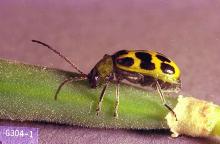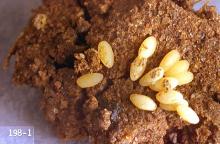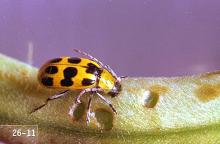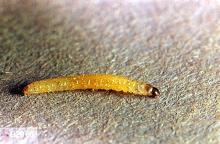Western spotted cucumber beetle (Diabrotica undecimpunctata)
Western striped cucumber beetle (Acalymma trivittatum)
Pest description, crop damage and life history
See:
Common Pests of Vegetable Crops
Biology and life history Cucumber beetles overwinter as fertilized females and are active beginning in early spring. Adults lay eggs at the base of plants. Eggs hatch in 7 to 10 days, and larvae feed in roots for about three weeks before pupating in the soil. Adults emerge in two weeks and begin feeding on pollen, plant foliage, flowers, and pods. It takes 30 to 60 days to complete a life cycle. There are two generations per year.
Pest monitoring Specific treatment thresholds have not been established for these foliage feeders in Oregon. In Virginia, the following recommendations are made: To prevent cucumber beetle damage to seedlings, treat when one beetle per 10 row ft is found. If damaging numbers are found during mid-year, excessive foliage loss may reduce crop production.
Sweep fields with a standard sweep net prior to first bloom. When one finds an average of two to four beetles per arc of the sweep net, treatment is justified.
Be aware of surrounding fields. As grass fields dry down before harvest, and when harvested vegetable crops are disked into the soil, sudden surges in beetle pressure may occur as beetles migrate in from other areas.
Experimental use of yellow sticky traps placed in the field just above the crop canopy suggests that, on average, if counts exceed two beetles per trap per day, treatment is justified if the crop is in a susceptible stage. A minimum action threshold has not been established. If trap counts are less than two beetles per trap per day, use a sweep net to make treatment decisions.
Management-cultural control
In most years, low ebbs occur in the aboveground adult beetle populations after egg laying and before the summer generation emerges. Sometimes, a crop planting can be delayed until after beetles have dispersed and deposited most of their eggs. Trap-and-spray crops sometimes can be used to draw beetles away from the main crop or to intercept incoming beetles at the edge of the field. Trap-cropping is an unproven technique in the PNW.
Management-chemical control: HOME USE
- azadirachtin (neem oil)-Some formulations are OMRI-listed for organic use.
- carbaryl
- esfenvalerate
- imidacloprid
- malathion
- pyrethrins (often combined with other ingredients)-Some formulations are OMRI-listed for organic use.
- zeta-cypermethrin
Management-chemical control: COMMERCIAL USE
- beta-cyfluthrin (Baythroid XL, Tombstone Helios) at 0.019 to 0.025 lb ai/A. PHI 7 days. REI 12 hr. Retreatment interval 14 days. Do not exceed 0.05 lb ai/A per season. Do not feed treated vines or hay to livestock. Toxic to bees, fish and aquatic invertebrates. Only registered for use in WA
- lambda-cyhalothrin (Warrior II) at 0.02 to 0.03 lb ai/A. PHI 21 days. REI 24 hr. Do not graze or feed to livestock. Do not exceed 0.12 lb ai/A per year. Do not apply within 25 ft of an aquatic habitat, 150 ft if applied by air.
- malathion (numerous products) at 0.61lbs/Ai/Aai/A. PHI 1 day. REI 12 hr. Do not graze or feed treated crop foliage to livestock.
- methomyl (Lannate SP) at 0.23 to 0.45 lb ai/A. PHI 14 days for harvest, feeding vines, and hay. REI 48 hr. Do not exceed 4.5 lb ai/A per year.
- zeta-cypermethrin (Mustang Maxx) at 0.017 to 0.025 lb ai/A). PHI 21 days. REI 12 hr. Retreatment interval 5 days. Do not exceed 0.15 lb ai/A per year. Do not apply within 25 ft of an aquatic habitat, 150 ft if applied by air.





